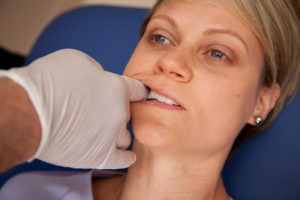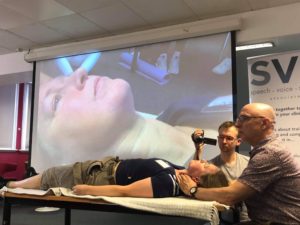TMJ disorder in the head and neck cancer patient
As I posted in my July 2019 newsletter, I want to introduce a paper that speaks to the frequency of TMJ disorder in post-head/neck cancer patients. While the treatment of TMJ is often relegated to PTs, the SLP is often seeing the greater percentage of head/neck cancer patients in the rehab setting, therefore becoming more aware of both the frequency of TMJ disorders and how it can contribute to the overall pattern of deficit in their patients is vital. While more commonly called upon for intervention in cases of post-radiation induced trismus, TMJ should and can be seen as a concurrent condition. Treatment of TMJ should be seen as within the normal purvue of the SLP as, at least from a manual therapy perspective, treatment to trismus and TMJ often have much in common.

Introduced to many of you during the MFR for Neck, Voice, and Swallowing Disorders Seminar, intervention to the area between the upper lateral maxilla and ramus of the mandible is one of my most commonly utilized treatment strategies for trismus and TMJ. While we go over other options, working to refine your skill and comfort here will pay dividends in terms of improving jaw opening and comfort.
The paper I refer to is, “Temporomandibular disorder in head and neck cancer patients undergoing radiotherapy: Clinical findings and patient-reported symptoms”. The researchers found,
“Overall, the clinical signs of TMD and the patient-reported symptoms were in agreement, both in terms of the onset and duration. The decreased mouth-opening capacity and tenderness of the muscles of mastication was reflected in the patient-reported outcomes of fatigue and stiffness of the jaw, pain upon moving the jaw, problems yawning, and problems with opening their mouth. There was a peak in the symptoms at 6 months after radiotherapy, and there was an improvement in most of the symptoms at the 12-month follow-up. However, problems with opening the mouth and muscular tenderness seemed to persist even at the 12-month follow-up.
Interestingly, facial pain, which is a common complaint among TMD patients in general, was not reported to increase in this study population after radiotherapy.”
“CONCLUSION A large proportion of patients with HNC show both objective and subjective signs of TMD prior to radiotherapy. During the first 12 months after radiotherapy, the signs and symptoms of TMD escalated, with symptoms peaking at 6 months after radiotherapy. Most commonly, patients suffer from restricted mouth opening, stiffness, fatigue, and pain of the jaw.”
The abstract for the paper may be found here. Manual therapy/MFR treatment to the TMJ and related is well supported in the literature. Specific studies may be accessed at this page of the website.
Cheers,
Walt Fritz, PT
Foundations in Myofascial Release Seminars
I am a proud member of the Medbridge Massage team of educators. I have 8 online courses, all presented from my updated, science-informed model of myofascial release. Take advantage of some pretty great discounts with a 12-month package of viewing, learning and CEUs with unlimited viewing of not only my (pretty great) courses but also over a dozen of the top educators in the massage profession. Approved for CEUs for all US MTs. Use the discount code FRITZmassage for the $49/year price by using this link: Medbridge Massage.

I can also offer some pretty great discounts to SLPs, PTs, and OTs through Medbridge Education. Click the image below here to have the discount applied.



Thanks for the summary Walt, this is relevant for my patient population!
Thanks, Therese, nice to hear from you.